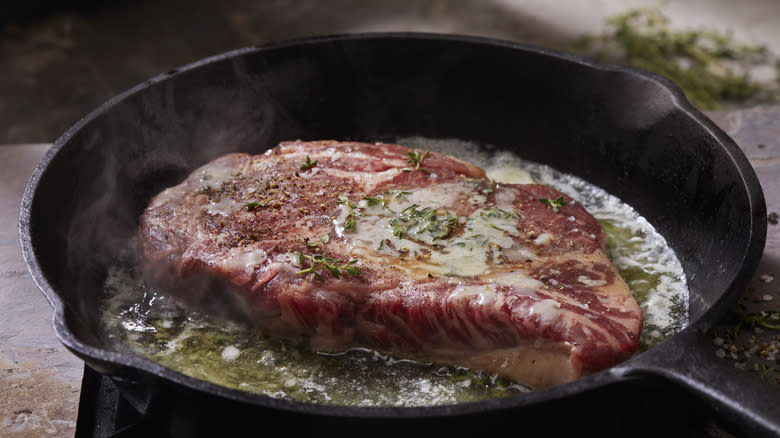What Does Butter Basting Steak Actually Do?

Nothing hits quite like a perfectly cooked steak. But there are all sorts of ways to get to that "perfectly cooked" description: you can grill it, of course, but you can also pan-sear it. While steak will taste great if you lightly season it and cook it in a pan to a brisk medium rare, there are ways to up your steak game, and one of them is by butter-basting it. You've doubtless seen this technique on TV, and if there's a cooking show where someone is making a steak, chances are they employ this method. But why does it work so well and what effect does it have on the steak? Isn't it just going to be a lot of trouble for not that much benefit?
The answer is that it genuinely does add a lot to your steak cooking. Though it's certainly going to make it taste even better (butter enhances everything, after all) the biggest effect butter-basting has is that it creates a perfect, crisp crust on your meat. If you've been struggling with that ideal sear, then the butter-basting method is something you have to try.
Read more: The 13 Best Steaks For Grilling
Butter Basting A Steak Gives You An Incredible Crust

A lot of cooking comes down to building flavor carefully over time, and this technique is a great example. What's happening here is you're essentially lacquering the steak, applying a coating of butter that forms a dense, uniform crust. This sort of crust doesn't form immediately, and you have to add layer upon layer of butter to build your crust. There's a similar principle at play with basting a turkey for Thanksgiving (although some people will argue you shouldn't baste a turkey at all).
The method here is pretty easy to understand: you cook the steak for two-thirds of the time in oil, then add butter to the pan. You then tilt the pan and repeatedly spoon the butter over the still-sizzling steak. While this takes a little more effort than simply cooking the thing on each side, the technique isn't all that complicated and the results are more than worth it.
What Are The Drawbacks To This Method?

While this technique certainly has its positives, there are still a few reasons it might not be ideal. Aside from the obvious fact that it takes a bit more effort, it's going to create a slight ring of grey under the crust. It won't cook it all the way through -- you'll still get a medium rare -- but if you want edge-to-edge red, this isn't the method for you, and you should go with something like a sous vide. Additionally, butter-basting is going to take a lot longer as you're tilting the steak away from the heat as you baste it, so it isn't going to cook as quickly. This is a method for if you have time to spare and want to impress with a restaurant-style steak.
That being said, there's no reason not to give this a try, particularly for those who eat steak regularly and want to switch it up. If you have the time and the inclination, try butter-basting next time you make a steak dinner -- you won't be disappointed.
Read the original article on Daily Meal.


